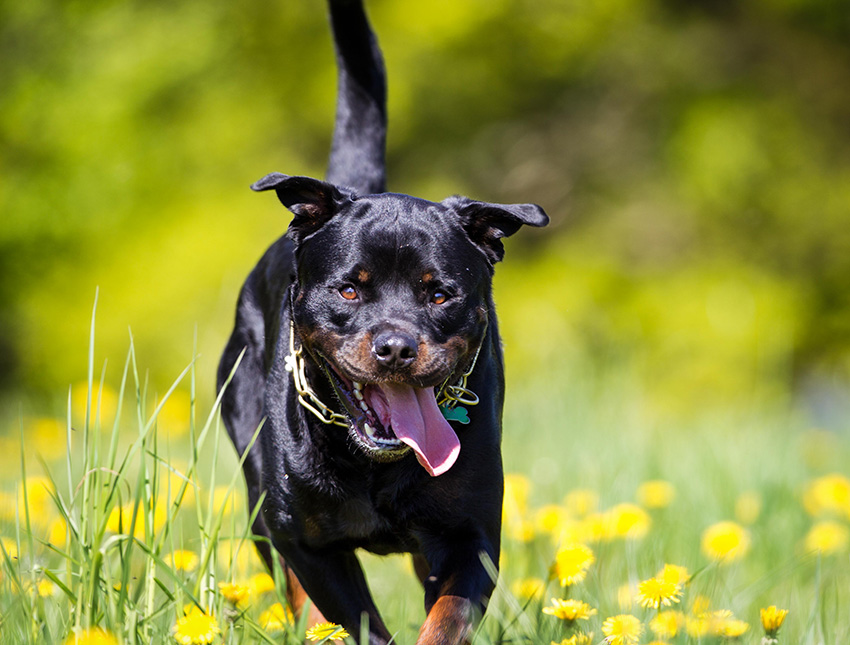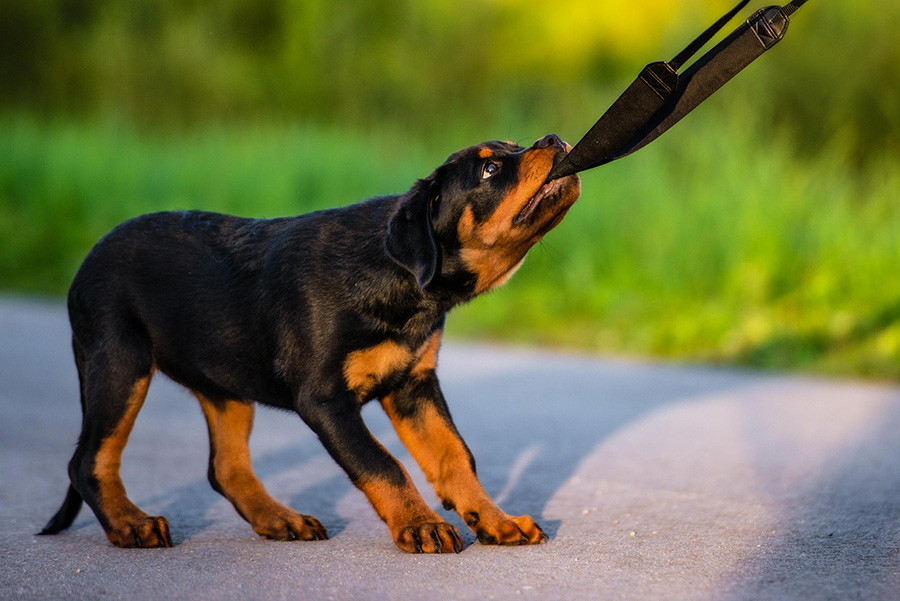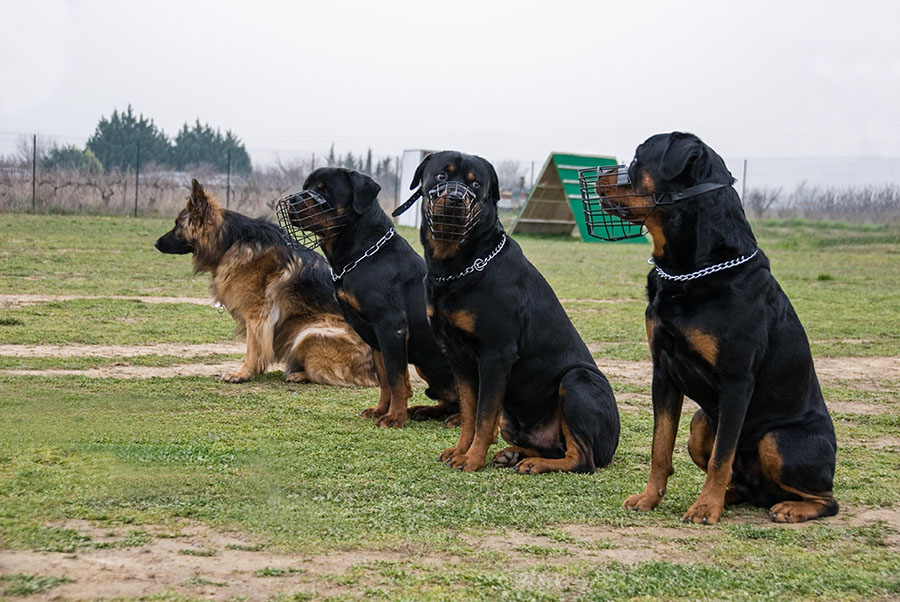The robust and compact figure, its fearless nature, and its great enthusiasm for work make the Rottweiler one of the most important service dogs in the United States. Here you will find everything you should know about this popular breed.
- History of the Rottweiler
- Appearance of the Rottweiler
- Traits and Characteristics of the Rottweiler
- How to Care for a Rottweiler?
- What to Consider When Buying a Rottweiler?
- Development and Training of a Rottweiler Puppy
- Activities with the Rottweiler
- Grooming a Rottweiler
- Health and Genetic Diseases
- Interesting and Informative Facts About the Rottweiler
History of the Rottweiler
The earliest evidence of the existence of the Rottweiler dates back to Roman times. Therefore, the breed is considered one of the oldest. The Romans primarily kept the sturdy dog as a herding and driving dog. These dogs also served in warfare and were used in spectacle fights against dogs, other animals, and even gladiators. The Romans’ dogs accompanied them across the Alps, protecting people and livestock on the arduous journey.
In the area around the town of Rottweil, they encountered local animals and interbred with them. In the Middle Ages, especially the butchers in the region took a liking to the strong and intelligent dog. They needed a strong herding dog for their sheep and cattle and continued to breed the breed. For this reason, the dogs were colloquially referred to as Rottweiler butcher dogs.
However, the butchers also used the dog as a protector of their property to prevent anyone from stealing money from them. The dog always carried the earned money in a leather bag around its neck. Due to its courage and strength, it also faced bulls and could be harnessed in front of a cart. Thanks to its strength and good obedience, the breed was officially recognized as a police dog in 1910.
During World War II, soldiers brutally exploited the obedience of the Rottweiler. The army equipped the dog with a mine on its back and sent it under the opponent’s tankers, where it exploded. They recklessly accepted the death of the animal. In the United States, the Rottie can still be found today as a guard or tracking dog mainly in the military or police force. Some also keep it as a vigilant family and farm dog.
The breed belongs to the FCI Group 2, Section 2, and thus to the Molossoids, such as the Hovawart or the Great Dane.
Breed Overview
GROUP: Working
HEIGHT: 22 to 27 inches at the shoulder
WEIGHT: 80 to 130 pounds
COAT: Short double coat
COAT COLOR: Black with tan, rust, or mahogany
LIFE SPAN: 8 to 10 years
TEMPERAMENT: Steady, alert, self-assured, fearless, devoted, confident, good-natured, obedient
HYPOALLERGENIC: No
ORIGIN: Germany
Appearance of the Rottweiler
The Rottweiler, an impressive dog of sturdy build, is characterized by its distinctive appearance. With a shoulder height of about 61 to 69 centimeters for males and slightly less for females, they are truly imposing animals. Their short, dense coat is usually black with distinct tan markings on the legs, chest, and face. This coloration gives them an unmistakable appearance.
Their muscular stature and well-defined contours emphasize their strength and robustness. The ears are usually upright and alert, contributing to their vigilant expression. Their dark eyes radiate intelligence and attentiveness. The tail is often docked, although this is now prohibited in many countries.
Overall, Rottweilers exude a powerful and majestic presence that reflects their origins as working dogs and guardians. This appearance alone can evoke respect and admiration and shows why they are often regarded as an impressive breed.
Traits and Characteristics of the Rottweiler
Despite the intimidating and threatening appearance of the Rottweiler, it has a friendly and peaceful nature. It gets along well with children, and other dogs pose no problem for it. If accustomed to them from a young age, the Rottie can also be kept together with cats. The spirited, industrious, and affectionate dog forms a strong bond with its owner. Especially at a young age, it may not assess its strength properly and react exuberantly when it sees its human. A well-trained Rottie is neither nervous nor aggressive and remains calm and vigilant even in stressful situations.
The loyal and affectionate dog has a strong protective instinct towards its family and is suspicious of strangers. To avoid incidents, you should train the four-legged friend consistently but lovingly. Generally, it is suitable only for experienced dog owners who can invest a lot of time in training. Due to its performance-oriented breeding, the Rottweiler remains active into old age and has a life expectancy of eight to ten years. It is eager to learn and needs a meaningful task and plenty of activity.
| Affection Level | High |
| Friendliness | High |
| Kid-Friendly | High |
| Pet-Friendly | Low |
| Exercise Needs | High |
| Playfulness | High |
| Energy Level | Medium |
| Trainability | High |
| Intelligence | High |
| Tendency to Bark | High |
| Amount of Shedding | Medium |
How to Care for a Rottweiler?
Keeping a Rottweiler requires responsibility and dedication to ensure that this loyal companion is happy and healthy. Here are some important steps to properly care for a Rottweiler:
- Exercise and Activity: Rottweilers are active dogs and require regular exercise. Your dog will love going for walks or playing with you.
- Nutrition: Pay attention to a balanced diet. High-quality dog food that meets your Rottweiler’s needs is important.
- Training: Rottweilers are intelligent and obedient, so training is important. Use positive reinforcement and consistency.
- Socialization: Early socialization is crucial to ensure that your Rottweiler gets along well with other dogs and people.
- Veterinary Visits: Regular veterinary visits are essential to monitor your dog’s health and keep vaccinations up to date.
- Love and Affection: Rottweilers are extremely loyal and need love and attention from their owners.
What to Consider When Buying a Rottweiler?
A Rottweiler is not a dog for beginners solely because of its strength. So if you want to get a Rottie, you should also be physically capable of handling the dog. The enduring working dog needs a reference person and plenty of activity from day one. It is best to keep the dog in a house with a large garden where it can roam around independently. In addition, an adult Rottweiler needs at least two hours of outdoor exercise every day. So, you should have the necessary fitness and time to meet the needs of a representative of this breed.
Unfortunately, Rottweilers often suffer from hereditary diseases. These include, like many other breeds, hip dysplasia. But the muscular dogs also often suffer from elbow dysplasia.
Other frequently occurring diseases include:
- Osteochondritis dissecans (OCD)
- Heart diseases: such as heart valve defects or cardiomyopathy
- Eye diseases: e.g., cataracts or progressive retinal atrophy (PRA).
- and blood disorders: VWD (Von Willebrand disease)
Regular preventive check-ups by a veterinarian are therefore particularly important.
If you can meet all the criteria, the next step is to find a suitable Rotti for you. For a purebred Rottweiler from a qualified breeder, you should budget at least $500. However, individual puppies can also cost up to $1200. There are some private breeders where you can buy dogs without papers much cheaper. Here you should be careful, as the animals often come from poor conditions or are sick.
If you want to save money and have experience with dogs, it’s better to go to the animal shelter. Here you will find well-maintained animals looking for a new home. Rottweilers with black fur with tan markings on the head, chest, and legs are most common. There are also some representatives with yellow, red, or brown fur.

Development and Training of a Rottweiler Puppy
Rottweilers need good socialization and close family bonding right from the start as puppies. As a young puppy, the Rottweiler is very playful in the first few months of life. Therefore, you should provide appropriate toys for him. It’s best to attend a dog school together. Here, the dog can learn to interact with other dogs. Additionally, you should consistently train a strong dog like the Rottie from the beginning.
You must make it clear to the dog that you are the “pack leader” and he should independently submit to you. While the Rottweiler is known for its fearless nature, it still reacts sensitively to punishment. Therefore, I recommend a loving upbringing without any physical sanctions, such as clicker training. If the Rottie doesn’t get enough exercise, he can develop unwanted behaviors very quickly, which can persist despite consistent training.

Activities with the Rottweiler
If you train your Rottweiler well, he will be a great partner in any sporting activity. The breed was primarily bred as a working dog and not as an endurance runner. So, you don’t need to go jogging with him often; instead, you should take him to dog sports. Due to his agility and good obedience, he is also particularly well suited for obedience training. Here, he can demonstrate his skills and learn at the same time that you are the higher-ranking family member. The Rottie also excels as a guard dog, as he attentively and conscientiously protects his family’s home and property.
The Rottweiler as a Family and Working Dog:
Rottweilers are amazing animals that have proven themselves both as family pets and working dogs. Their loyalty and protective instincts make them ideal family pets. They love spending time with their family and are generally gentle, especially with children.
At the same time, Rottweilers have a long history as working dogs. Originally used in agriculture to herd livestock and transport goods, they are still valued in various fields of work today, including as police dogs and search and rescue dogs.
The breed is particularly popular for service in the military or police due to their nerves of steel and pronounced protective instinct. The Military Dog Center Kaisersteinbruch in Austria is the largest Rottweiler breeding center in the world, with over 1,500 military dogs bred. The dogs are mainly used for guarding technical facilities, airports, ammunition depots, and restricted areas. The recognized service dog is also active in mountain or water rescue.

Grooming a Rottweiler
Caring for your Rottweiler is of great importance to ensure that your faithful friend remains healthy and happy. Here are some key points for caring for your Rottweiler:
- Coat Care: Regularly brush your Rottweiler’s short, dense coat. This removes loose hair and keeps the coat healthy and shiny.
- Bathing: Bathe your Rottweiler as needed. Use a mild dog shampoo to avoid irritating the skin.
- Nutrition: Ensure a balanced diet with high-quality dog food. Provide the right amount of food according to your dog’s weight and age.
- Exercise: Your Rottweiler needs regular exercise. Take him for walks and play to provide him with enough physical and mental activity.
- Socialization: Early socialization is important so that your Rottweiler feels comfortable around other dogs and people.
- Training: Use positive training to educate your Rottweiler. Be consistent and loving in your approach.
- Veterinary Visits: Schedule regular veterinary visits to monitor your Rottweiler’s health and keep vaccinations up to date.
- Affection: Show your love and affection to your Rottweiler. They are extremely loyal and need your attention.
- Dental Care: Pay attention to dental care by offering chew toys or dental toys. This helps prevent dental problems.
- Weight Control: Keep an eye on your Rottweiler’s weight to avoid overweight. Obesity can cause health problems.
Proper care ensures that your Rottweiler leads a happy and healthy life and can build a strong bond with you.
Health and Genetic Diseases
Your Rottweiler’s health is of paramount importance to ensure he leads a long and happy life. Here are some important insights into health and possible genetic diseases that can affect Rottweilers:
- Hip Dysplasia: Hip dysplasia is a common genetic disease in Rottweilers. It can lead to pain and lameness. Regular veterinary examinations and a healthy diet are important to minimize the risk.
- Heart Diseases: Rottweilers are susceptible to heart diseases such as dilated cardiomyopathy. Regular heart examinations by a veterinarian are advisable.
- Elbow Dysplasia: This is a genetic disease that affects the joints. Watch for signs of lameness and pain.
- Eye Problems: Rottweilers can develop eye problems such as cataracts. Regular eye examinations are important.
- Cancer: Like many dog breeds, Rottweilers are susceptible to cancer. Watch for signs such as ulcers or behavioral changes.
- Allergies: Some Rottweilers may develop allergies to certain foods or environmental factors. Pay attention to your dog’s diet and environment.
- Vaccinations: Ensure that your Rottweiler receives the necessary vaccinations to protect against serious diseases.
By carefully monitoring your Rottweiler’s health and responding early to potential problems, you can ensure that your faithful companion leads a happy and healthy life.
Interesting and Informative Facts About the Rottweiler
Are Rottweilers considered dangerous dogs? Rottweilers are classified as potentially dangerous dogs in some cities and towns. Depending on the state, owning this breed comes with strict regulations, including additional costs such as licensing fees, temperament tests, and extra taxes. Moreover, having a comprehensive dog liability insurance policy is highly recommended, if not mandatory, in some states.
One notable incident involving a Rottweiler named Pascha from Duisburg garnered significant attention. The dog attacked a three-year-old girl in the city, inflicting severe bite wounds. On that day, the dog was not wearing a muzzle, contrary to the regulations, and was accompanied by a friend of the owner. As a result, the dog was euthanized, sparking a heated debate about the negligent handling of so-called “dangerous dogs.” Incidents like this have contributed to the Rottweiler’s reputation as a “biting machine” and have led to a stigma against the breed. However, it’s important to note that Rottweilers were never selectively bred for aggression but rather were raised to be family-friendly companions, originating from an ancient working breed.
Rottweilers in Film and Television:
The Rottweiler’s impressive appearance alone makes it a popular choice among many celebrities. Actor Will Smith, for instance, owned five Rottweilers at the same time. Similarly, Bruno Mars and Robbie Williams each own a Rottweiler.
Due to its often intimidating and aggressive appearance, the Rottweiler is frequently utilized as a symbol of fear in movies and advertising campaigns. In the Spanish film “Rottweiler,” for example, a brutal dog that is half animal and half machine takes on the lead role. Additionally, in commercials, the Rottweiler is commonly portrayed as aggressive and menacing. In the UK, the term “Rottweiler politics” is even used during political debates where one opponent aggressively attacks another.
Do you own a Rottweiler or plan to get one soon? Share in the comments what makes them special to you!


